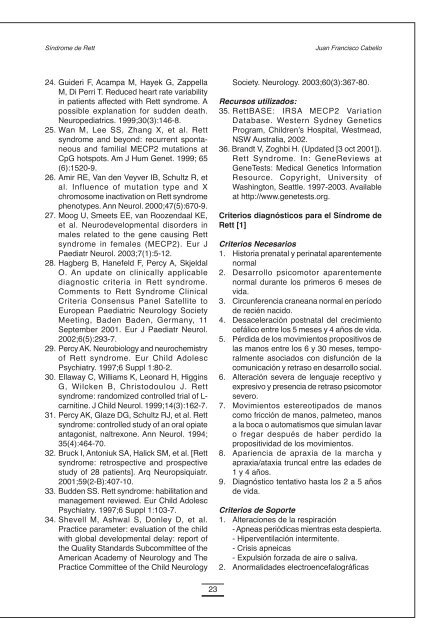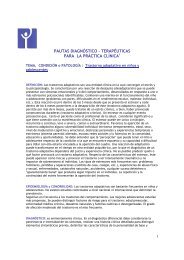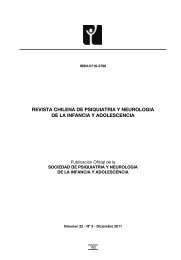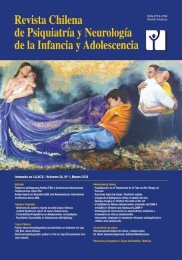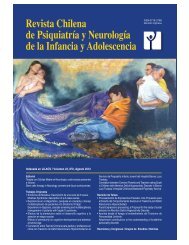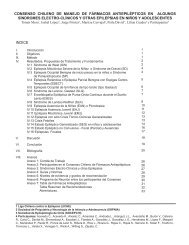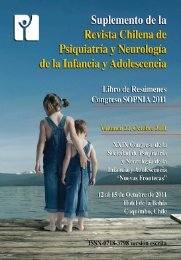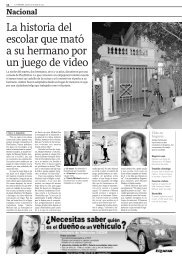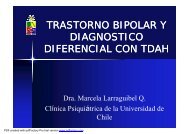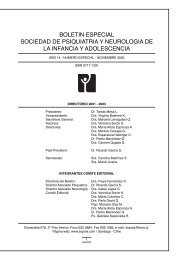boletin sociedad de psiquiatria y neurologia de la infancia y ...
boletin sociedad de psiquiatria y neurologia de la infancia y ...
boletin sociedad de psiquiatria y neurologia de la infancia y ...
You also want an ePaper? Increase the reach of your titles
YUMPU automatically turns print PDFs into web optimized ePapers that Google loves.
Síndrome <strong>de</strong> RettJuan Francisco Cabello24. Gui<strong>de</strong>ri F, Acampa M, Hayek G, Zappel<strong>la</strong>M, Di Perri T. Reduced heart rate variabilityin patients affected with Rett syndrome. Apossible exp<strong>la</strong>nation for sud<strong>de</strong>n <strong>de</strong>ath.Neuropediatrics. 1999;30(3):146-8.25. Wan M, Lee SS, Zhang X, et al. Rettsyndrome and beyond: recurrent spontaneousand familial MECP2 mutations atCpG hotspots. Am J Hum Genet. 1999; 65(6):1520-9.26. Amir RE, Van <strong>de</strong>n Veyver IB, Schultz R, etal. Influence of mutation type and Xchromosome inactivation on Rett syndromephenotypes. Ann Neurol. 2000;47(5):670-9.27. Moog U, Smeets EE, van Roozendaal KE,et al. Neuro<strong>de</strong>velopmental disor<strong>de</strong>rs inmales re<strong>la</strong>ted to the gene causing Rettsyndrome in females (MECP2). Eur JPaediatr Neurol. 2003;7(1):5-12.28. Hagberg B, Hanefeld F, Percy A, SkjeldalO. An update on clinically applicablediagnostic criteria in Rett syndrome.Comments to Rett Syndrome ClinicalCriteria Consensus Panel Satellite toEuropean Paediatric Neurology SocietyMeeting, Ba<strong>de</strong>n Ba<strong>de</strong>n, Germany, 11September 2001. Eur J Paediatr Neurol.2002;6(5):293-7.29. Percy AK. Neurobiology and neurochemistryof Rett syndrome. Eur Child AdolescPsychiatry. 1997;6 Suppl 1:80-2.30. El<strong>la</strong>way C, Williams K, Leonard H, HigginsG, Wilcken B, Christodoulou J. Rettsyndrome: randomized controlled trial of L-carnitine. J Child Neurol. 1999;14(3):162-7.31. Percy AK, G<strong>la</strong>ze DG, Schultz RJ, et al. Rettsyndrome: controlled study of an oral opiateantagonist, naltrexone. Ann Neurol. 1994;35(4):464-70.32. Bruck I, Antoniuk SA, Halick SM, et al. [Rettsyndrome: retrospective and prospectivestudy of 28 patients]. Arq Neuropsiquiatr.2001;59(2-B):407-10.33. Bud<strong>de</strong>n SS. Rett syndrome: habilitation andmanagement reviewed. Eur Child AdolescPsychiatry. 1997;6 Suppl 1:103-7.34. Shevell M, Ashwal S, Donley D, et al.Practice parameter: evaluation of the childwith global <strong>de</strong>velopmental <strong>de</strong><strong>la</strong>y: report ofthe Quality Standards Subcommittee of theAmerican Aca<strong>de</strong>my of Neurology and ThePractice Committee of the Child NeurologySociety. Neurology. 2003;60(3):367-80.Recursos utilizados:35. RettBASE: IRSA MECP2 VariationDatabase. Western Sydney GeneticsProgram, Children’s Hospital, Westmead,NSW Australia, 2002.36. Brandt V, Zoghbi H. (Updated [3 oct 2001]).Rett Syndrome. In: GeneReviews atGeneTests: Medical Genetics InformationResource. Copyright, University ofWashington, Seattle. 1997-2003. Avai<strong>la</strong>bleat http://www.genetests.org.Criterios diagnósticos para el Síndrome <strong>de</strong>Rett [1]Criterios Necesarios1. Historia prenatal y perinatal aparentementenormal2. Desarrollo psicomotor aparentementenormal durante los primeros 6 meses <strong>de</strong>vida.3. Circunferencia craneana normal en período<strong>de</strong> recién nacido.4. Desaceleración postnatal <strong>de</strong>l crecimientocefálico entre los 5 meses y 4 años <strong>de</strong> vida.5. Pérdida <strong>de</strong> los movimientos propositivos <strong>de</strong><strong>la</strong>s manos entre los 6 y 30 meses, temporalmenteasociados con disfunción <strong>de</strong> <strong>la</strong>comunicación y retraso en <strong>de</strong>sarrollo social.6. Alteración severa <strong>de</strong> lenguaje receptivo yexpresivo y presencia <strong>de</strong> retraso psicomotorsevero.7. Movimientos estereotipados <strong>de</strong> manoscomo fricción <strong>de</strong> manos, palmeteo, manosa <strong>la</strong> boca o automatismos que simu<strong>la</strong>n <strong>la</strong>varo fregar <strong>de</strong>spués <strong>de</strong> haber perdido <strong>la</strong>propositividad <strong>de</strong> los movimientos.8. Apariencia <strong>de</strong> apraxia <strong>de</strong> <strong>la</strong> marcha yapraxia/ataxia truncal entre <strong>la</strong>s eda<strong>de</strong>s <strong>de</strong>1 y 4 años.9. Diagnóstico tentativo hasta los 2 a 5 años<strong>de</strong> vida.Criterios <strong>de</strong> Soporte1. Alteraciones <strong>de</strong> <strong>la</strong> respiración- Apneas periódicas mientras esta <strong>de</strong>spierta.- Hiperventi<strong>la</strong>ción intermitente.- Crisis apneicas- Expulsión forzada <strong>de</strong> aire o saliva.2. Anormalida<strong>de</strong>s electroencefalográficas23


